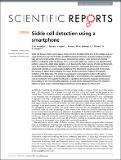Sickle cell detection using a smartphone
Author(s)
Knowlton, S. M.; Sencan, I.; Khoory, J.; Heeney, M. M.; Ghiran, I. C.; Tasoglu, S.; Aytar, Yusuf; ... Show more Show less
DownloadKnowlton_Sickle cell detection.pdf (1.282Mb)
PUBLISHER_CC
Publisher with Creative Commons License
Creative Commons Attribution
Terms of use
Metadata
Show full item recordAbstract
Sickle cell disease affects 25% of people living in Central and West Africa and, if left undiagnosed, can cause life threatening “silent” strokes and lifelong damage. However, ubiquitous testing procedures have yet to be implemented in these areas, necessitating a simple, rapid, and accurate testing platform to diagnose sickle cell disease. Here, we present a label-free, sensitive, and specific testing platform using only a small blood sample (<1 μl) based on the higher density of sickle red blood cells under deoxygenated conditions. Testing is performed with a lightweight and compact 3D-printed attachment installed on a commercial smartphone. This attachment includes an LED to illuminate the sample, an optical lens to magnify the image, and two permanent magnets for magnetic levitation of red blood cells. The sample is suspended in a paramagnetic medium with sodium metabisulfite and loaded in a microcapillary tube that is inserted between the magnets. Red blood cells are levitated in the magnetic field based on equilibrium between the magnetic and buoyancy forces acting on the cells. Using this approach, we were able to distinguish between the levitation patterns of sickle versus control red blood cells based on their degree of confinement.
Date issued
2015-10Department
Massachusetts Institute of Technology. Computer Science and Artificial Intelligence LaboratoryJournal
Scientific Reports
Publisher
Nature Publishing Group
Citation
Knowlton, S. M., I. Sencan, Y. Aytar, J. Khoory, M. M. Heeney, I. C. Ghiran, and S. Tasoglu. “Sickle Cell Detection Using a Smartphone.” Scientific Reports 5 (October 22, 2015): 15022.
Version: Final published version
ISSN
2045-2322